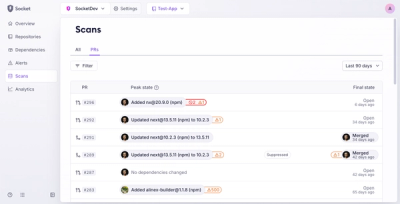
Research
/Security News
DuckDB npm Account Compromised in Continuing Supply Chain Attack
Ongoing npm supply chain attack spreads to DuckDB: multiple packages compromised with the same wallet-drainer malware.
CLI output formatting tools: "Your CLI Formatting Friend".
curl http://npmjs.org/install.sh | sh
[sudo] npm install cliff
There are a number of methods available in Cliff for common logging tasks in command-line tools. If you're looking for more usage, checkout the examples in this repository:
cliff.stringifyRows(rows[, colors])
Takes a set of Arrays and row headers and returns properly formatted and padded rows. Here's a sample:
var cliff = require('../lib/cliff');
var rows = [
['Name', 'Flavor', 'Dessert'],
['Alice', 'cherry', 'yogurt'],
['Bob', 'carmel', 'apples'],
['Joe', 'chocolate', 'cake'],
['Nick', 'vanilla', 'ice cream']
];
console.log(cliff.stringifyRows(rows, ['red', 'blue', 'green']));

cliff.putRows(level, rows[, colors])
The putRows method is a simple helper that takes a set of Arrays and row headers and logs properly formatted and padded rows (logs stringifyRows to winston). Here's a quick sample:
var cliff = require('../lib/cliff');
var rows = [
['Name', 'Flavor', 'Dessert'],
['Alice', 'cherry', 'yogurt'],
['Bob', 'carmel', 'apples'],
['Joe', 'chocolate', 'cake'],
['Nick', 'vanilla', 'ice cream']
];
cliff.putRows('data', rows, ['red', 'blue', 'green']);
The resulting output on the command-line would be:

cliff.stringifyObjectRows(objs, properties[, colors]) used to be: cliff.rowifyObjects(objs, properties, colors)
Takes a set of Objects and the properties to extract from them and returns properly formatted and padded rows. Here's a sample:
var cliff = require('../lib/cliff');
var objs = [], obj = {
name: "bazz",
address: "1234 Nowhere Dr.",
};
for (var i = 0; i < 10; i++) {
objs.push({
name: obj.name,
address: obj.address,
id: Math.random().toString()
});
}
console.log(cliff.stringifyObjectRows(objs, ['id', 'name', 'address'], ['red', 'blue', 'green']));

cliff.putObjectRows(level, objs, properties[, colors])
Takes a set of Objects and the properties to extract from them and it will log to the console. (it prints stringifyObjectRows with winston). Here's a sample:
var cliff = require('../lib/cliff');
var objs = [], obj = {
name: "bazz",
address: "1234 Nowhere Dr.",
};
for (var i = 0; i < 10; i++) {
objs.push({
name: obj.name,
address: obj.address,
id: Math.random().toString()
});
}
cliff.putObjectRows('data', objs, ['id', 'name', 'address']);

Colors Parameter
The colors parameter is an array that colors the first row. It uses the colors.js. You can use any of those.
var cliff = require('../lib/cliff');
var rows = [
['Name', 'Flavor', 'Dessert'],
['Alice'.grey, 'cherry'.cyan, 'yogurt'.yellow],
['Bob'.magenta, 'carmel'.rainbow, 'apples'.white],
['Joe'.italic, 'chocolate'.underline, 'cake'.inverse],
['Nick'.bold, 'vanilla', 'ice cream']
];
cliff.putRows('data', rows, ['red', 'blue', 'green']);
The resulting output on the command-line would be:

cliff.inspect(obj)
The inspect method is a lightweight wrapper to a pre-configured eyes inspector. If you wish to change the coloring of objects that are logged using cliff you only need to override cliff.inspect with a new eyes inspector. Here is how to use it:
var cliff = require('../lib/cliff');
console.log(cliff.inspect({
literal: "bazz",
arr: [
"one",
2,
],
obj: {
host: "localhost",
port: 5984,
auth: {
username: "admin",
password: "password"
}
}
}));

cliff.putObject(obj, [rewriters, padding])
The putObject method is a simple helper function for prefixing and styling inspected object output from eyes. Here's a quick sample:
var cliff = require('cliff');
cliff.putObject({
literal: "bazz",
arr: [
"one",
2,
],
obj: {
host: "localhost",
port: 5984,
auth: {
username: "admin",
password: "password"
}
}
});
The resulting output on the command-line would be:

All of the cliff tests are written in vows, and cover all of the use cases described above.
npm test
Cliff is the swiss army knife of CLI formatting tools. It is based on highly flexible and powerful libraries:
FAQs
Your CLI formatting friend.
The npm package cliff receives a total of 249,144 weekly downloads. As such, cliff popularity was classified as popular.
We found that cliff demonstrated a not healthy version release cadence and project activity because the last version was released a year ago. It has 2 open source maintainers collaborating on the project.
Did you know?

Socket for GitHub automatically highlights issues in each pull request and monitors the health of all your open source dependencies. Discover the contents of your packages and block harmful activity before you install or update your dependencies.

Research
/Security News
Ongoing npm supply chain attack spreads to DuckDB: multiple packages compromised with the same wallet-drainer malware.

Security News
The MCP Steering Committee has launched the official MCP Registry in preview, a central hub for discovering and publishing MCP servers.

Product
Socket’s new Pull Request Stories give security teams clear visibility into dependency risks and outcomes across scanned pull requests.